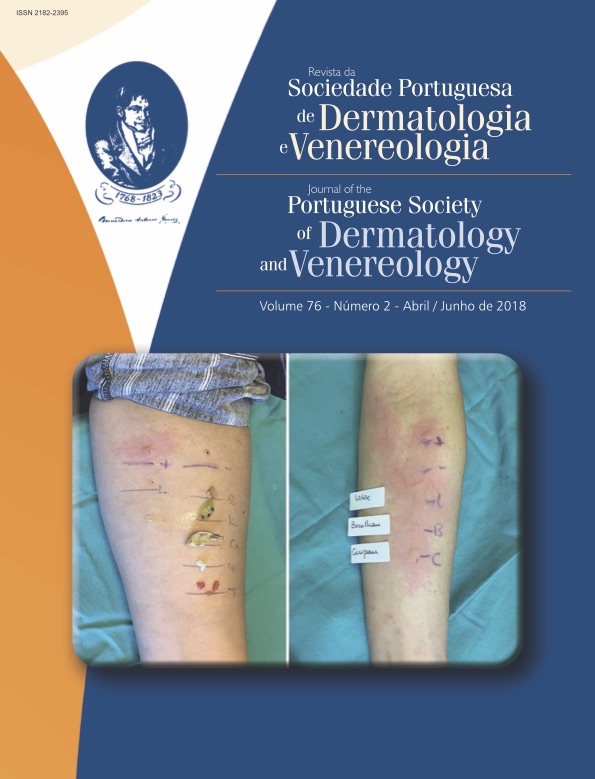Ciclosporina no Tratamento da Urticária Crónica Espontânea na Era do Omalizumab
Resumo
Introdução: Na urticária crónica espontânea (UCE) refratária a anti-histamínicos, as recomendações nacionais propõem utilizar o omalizumab mas este nem sempre está prontamente disponível, justificando-se discutir o valor de outros fármacos. Neste contexto, analisámos a eficácia e a segurança da ciclosporina e explorámos a relação entre características da urticária e a resposta terapêutica.
Material e Métodos: Estudo retrospetivo num serviço de dermatologia (2010-2016). Foram reunidos dados demográficos, clínico-evolutivos e laboratoriais da UCE moderada a grave tratada com ciclosporina, dose, duração do tratamento, período de follow-up e reações adversas. A eficácia foi avaliada pela escala de atividade da urticária durante 7 dias (UAS7). A significância estatística foi definida para 0,05.
Resultados: Foram estudados 23 doentes (19 feminino/4 masculino; idade média 46,0 ± 14,0 anos) com UCE que evolui há 129,7 ± 128,1 meses, tratados com ciclosporina numa dose média de 3,2 ± 0,3 mg/kg. Em 10 doentes (44%) observou-se boa resposta logo no primeiro mês com redução significativa do UAS7 (UAS7 ≤ 6) relativamente aos não respondedores (p < 0,05). Ocorreram eventos adversos em oito doentes, com necessidade de suspensão em seis (hipertensão arterial não controlada ou infeções). Nenhum dos dados avaliados mostrou relação com a resposta terapêutica.
Conclusão: A ciclosporina, eficaz em 44% dos doentes com urticária moderada a grave, poderá ser considerada alternativa ao omalizumab, quando este não está disponível, mas com monitorização estreita de eventos adversos.
Downloads
Referências
Costa C, Gonçalo M. Abordagem diagnóstica e terapêutica da urticária crónica espontânea: recomendações em Portugal. Acta Med Port. 2016;29:763-81.
Gaig P, Olona M, Muñoz Lejarazu D, Caballero MT, Domínguez FJ, Echechipia S, et al. Epidemiology of urticaria in Spain. J Investig Allergol Clin Immunol. 2004;14:214-20.
Asero R, Pinter E, Marra AM, Tedeschi A, Cugno M, Marzano AV. Current challenges and controversies in the management of chronic spontaneous urticaria. Expert Rev Clin Immunol. 2015;11:1073-82.
Kolkhir P, André F, Church MK, Maurer M, Metz M. Potential blood biomarkers in chronic spontaneous urticaria. Clin Exp Allergy. 2017; 47:19-36.
Ferrer M. Immunological events in chronic spontaneous urticaria. Clin Transl Allergy. 2015;5:30.
Viegas LP, Ferreira MB, Kaplan AP. The maddening itch: an approach to chronic urticaria. J Investig Allergol Clin Immunol. 2014;24:1-5.
Costa AC, Campina S, Andrade P, Filipe P, Guilherme A, Gonçalo M. Urticária crónica – do diagnóstico ao tratamento. Rev Soc Port Dermatol Venereol. 2016;74: 315-25.
Kaplan AP. Clinical practice. Chronic urticaria and angioedema. N Engl J Med. 2002; 346:175-9.
Zuberbier T, Aberer W, Asero R, Abdul Latiff AH, Baker D, Ballmer-Weber B, et al. The EAACI/GA2LEN/EDF/WAO Guideline for the Definition, Classification, Diagnosis and Management of Urticaria. The 2017 Revision and Update. Allergy. 2018 (in press).
Marzano A V, Pigatto P, Cristaudo A, Ayala F, Rossi O, Senna G, et al. Management of chronic spontaneous urticaria: practical parameters. G Ital Dermatol Venereol. 2015; 150:237-46.
Chang TW, Chen C, Lin CJ, Metz M, Church MK, Maurer M. The potential pharmacologic mechanisms of omalizumab in patients with chronic spontaneous urticarial. J Allergy Clin Immunol. 2015;135:337-42.
Khalaf A, Li W, Jinquan T. Current advances in the management of urticaria. Arch Immunol Ther Exp. 2008; 56:103-14.
Ferrer M, Bartra J, Giménez-Arnau A, Jauregui I, Labrador-Horrillo M, Ortiz de Frutos J, et al. Management of urticaria: not too complicated, not too simple. Clin Exp Allergy. 2015; 45:731-43.
Weller K, Zuberbier T, Maurer M. Chronic urticaria: tools to aid the diagnosis and assessment of disease status in daily practice. J Eur Acad Dermatol Venereol. 2015; 29 (Suppl 3):38-44.
Kessel A, Toubi E. Low-dose cyclosporine A is a good option for severe chronic urticaria. J Allergy Clin Immunol. 2009;123:970.
Savic S, Marsland A, McKay D, Ardern-Jones MR, Leslie T, Somenzi O, et al. Retrospective case note review of chronic spontaneous urticarial outcomes and adverse effects in patients treated with omalizumab or ciclosporin in UK secondary care. Allergy Asthma Clin Immunol. 2015;11:21.
Godse KV. Cyclosporine in chronic idiopathic urticarial with positive autologous serum skin test. Indian J Dermatol. 2008;53:101-2.
Mehta A Godse K, Patil S, Nadkarni N, Gautam M. Treatment of refractory chronic urticaria. Indian J Dermatol. 2015;60:230-7.
Boubouka CD, Charissi C, Kouimintzis D, Kalogeromitros D, Stavropoulos PG, Katsarou A. Treatment of autoimmune urticaria with low-dose cyclosporin A: A one-year follow-up. Acta Derm Venereol. 2011;91:50-4.
Baskan EB, Tunali S, Turker T, Saricaoglu H. Comparison of short- and long-term cyclosporine A therapy in chronic idiopathic urticaria. J Dermatolog Treat. 2004;15:164-8.
Hollander SM, Joo SS, Wedner HJ. Factors that predict the success of cyclosporine treatment for chronic urticaria. Ann Allergy Asthma Immunol. 2011;107:523-8.
Seth S, Khan DA. The comparative safety of multiple alternative agents in refractory chronic urticarial patients. J Allergy Clin Immunol Pract. 2017;5:165-70.
Kessel A, Toubi E. Cyclosporine-A in severe chronic urticaria: the option for long-term therapy. Allergy. 2010;65:1478-82.
Chang HW, Cheng HM, Yen HR, Hsu CY, Lee YC, Chiang JH, et al. Association between chronic idiopathic urticaria and hypertension: A population-based retrospective cohort study. Ann Allergy Asthma Immunol. 2016;116:554-8.
Giménez-Arnau AM. Omalizumab for treating chronic spontaneous urticaria: an expert review on efficacy and safety. Expert Opin Biol Ther. 2017;17:375-85.
Todos os artigos desta revista são de acesso aberto sob a licença internacional Creative Commons Attribution-NonCommercial 4.0 (CC BY-NC 4.0).








